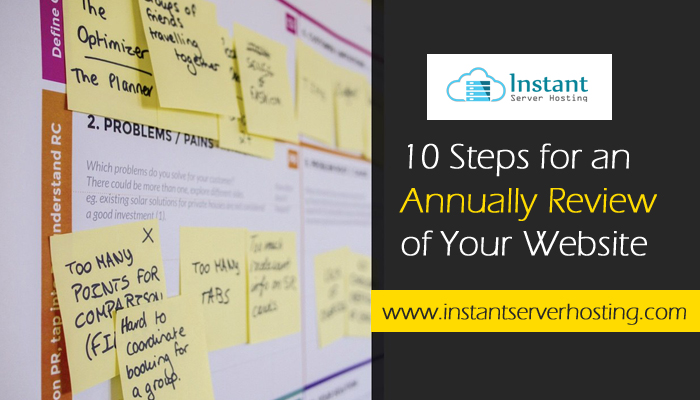Every website that you create has its own unique goals and target audience. But when it comes time to review your website, what steps should you take? It can be daunting, but here are 10 steps to help make your review a success! This blog article provides steps for looking at your website from different angles, including the social media side of things. It may seem daunting to review your website annually, but if you’re interested in your site’s growth and the influx of backlines and traffic, it’s essential to do this regularly. Performance is critical when it comes to your website. You want to ensure that your content loads quickly and that visitors can access everything they need on your site.
As your website ages, it’s essential that you periodically take a step back to evaluate the progress and make any necessary changes or improvements to keep it growing. It’s best to schedule this evaluation every year to help avoid any surprises down the line. It’s also about ensuring your site is functioning as expected or not needing to be updated. While you might have a system in place for this, it’s always better to go through this process at the beginning of every year and so you don’t miss critical updates.
Key of Benefits an Annual Review
The benefits of conducting an annual review of your website are numerous and wide-ranging, but include the following:
1. Improving Website Traffic and Conversion Rates
A well-done annual review can help you to identify any changes in website traffic or conversion rates that may warrant further attention. This information can then be used to tweak your marketing strategy accordingly, ensuring that your website continues to reach and convert more visitors.
2. Enhancing Site Usability and Navigation
By closely examining how users interact with your site, you can improve all visitors’ overall usability and navigation experience. This will make it easier for them to find what they’re looking for, whether related content or specific product info.
10 Steps to a Year-End Website Review
If you’re like most small business owners, your website is one of your most essential marketing tools. But like any tool, it can be used for good or bad if it’s not maintained and updated. To complete your year-end website review, there are a few key steps you should take:
- Check for broken links and outdated information
- Identify any missing contact information or logos
- Review your website’s navigation and structure
- Evaluate your website’s performance
- Manage your performance review file and portfolio
- Scout out security improvements
- Site Usability and Navigation
- Deal with cross-browser and device testing
- Conduct a site analysis
- Review Google Analytics reports
1. Check for broken links and outdated information
Make sure all of your external links are working correctly – if not, use a link-checking tool like Google Webmaster Tools or Majestic SEO to identify broken links and update them as needed. Also, make sure all of your site’s text is up-to-date (including copyright dates) and any images that may be used.
2. Identify any missing contact information or logos
Include your contact information (name, email address, phone number) and any company logos or trademarks you may use on your site. If you have any social media accounts associated with your business, include their URLs in this section.
3. Review your website’s navigation and structure.
Make sure your site is easy to find and navigate, with simple menu navigation and labeled headings. Give yourself time to check all the essential areas of your site – from the home page to the main content pages to the sidebar and footer.
4. Evaluate your website’s performance
Keeping a few key factors in mind when evaluating your website’s performance would be best. Overall, speed is essential, but so is the efficiency of individual pages and modules. You also want to make sure that your site works well on all devices and browsers, both modern and legacy ones.
Use tools like Google Page Speed Insights or Webpage test to get an accurate picture of your website’s performance. These tools measure how quickly your pages load on different devices and networks and how well they’re coded. They can also help you identify any issues that may slow down your site.
5. Manage your performance review file and portfolio
Review your performance review file to identify key objectives and outcomes you want to achieve in the next 12 months. Use this information when preparing your annual objectives and goals. When designing your website portfolio, be sure to highlight both your strengths and areas for improvement. This will help you demonstrate how you have achieved results and improve your chances of being selected for a year-end website review.
6. Scout out security improvements
First and foremost, it is essential to scout out any potential security improvements that could be made on your website. This includes looking for areas where vulnerabilities might exist and upgrading any outdated security measures.
It is also a good idea to occasionally review your website’s logs to identify any abnormal activity or traffic patterns. This information can help you track any potential cyber-attacks or other suspicious activity.
Finally, keeping up with the latest security updates and patches for your software and browsers is essential. By doing so, you will avoid any potential vulnerabilities on your website.
7. Site Usability and Navigation
Make use of clear and concise navigation menus that are easy to understand and follow without having to scroll through long lists of links. And finally, make sure all pages are designed to be easy on the eyes – use fonts that are legible at a distance, avoid fancy graphics and animations, etc.
8. Deal with cross-browser and device testing
When it comes to cross-browser and device testing, there are a few things that you need to keep in mind. One of the most important things is that your tests must be repeatable and consistent across different browsers and devices. Additionally, you’ll need to test on as many other devices as possible to ensure that your application performs as expected. One way to improve your cross-browser and device testing process is by using automated tools. These tools allow you to inspect the HTML and CSS of a web page in real-time. This information can help you identify issues with the design or code of your website. These tools can help you identify problems with your code before they even occur, saving you time and hassle.
9. Conduct a site analysis
Your website is an integral part of your business and should be reviewed annually to ensure that it is effective and meets your customers’ needs. A site analysis will help you identify any changes that need to be made, evaluate how users are interacting with your website, and determine whether your website is meeting the goals you set for it.
10. Review Google Analytics reports
To ensure your website performs as best as possible, you should review Google Analytics reports at least once yearly. By reviewing your data, you can identify any changes and improvements needed to keep your site running smoothly.
To get started, open your Google Analytics account. This free service provides detailed information about how people use your website. To see the reports you need to review, click on the “analytics” tab at the top of your screen and select “Website Traffic.”
Reviewing traffic data gives you a snapshot of how people interact with your website. You can see what pages are being visited most often, what keywords drive traffic, and how users behave on your site.
Conclusion
Website annual reviews can be a great way to ensure that your website is meeting the needs of your target audience and continuing to grow. It’s important to remember that your website is a representation of you and your business. Every year, it’s a good idea to take the time to review and update your website to reflect the changes in your industry and what you’re offering your customers. By keeping up with the latest trends, you’ll be sure that your website looks professional and reflects the quality and content of your company. If you get much information about the 10 Best tools to check your website rank. Visit this link.







